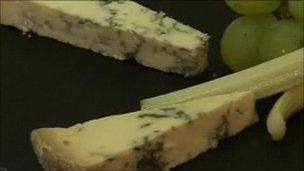Stilton villagers in fight for blue cheese name
- Published
The village of Stilton may have lent its name to the famous blue cheese, but residents are facing a battle to use the name themselves.
An EU law only allows Stilton to be produced by six farms in three East Midlands counties, where it is believed the product originated.
It was thought that the cheese was named after Stilton because it was only sold in the village, not made there.
But one resident has uncovered 18th Century documents that could show the cheese was made in Cambridgeshire.
Richard Landy said he wants to use research he has done to overturn the EU ruling, and begin making Stilton in the village it was named after.
He is convinced that documents from the 1720s prove that the forerunner of today's blue Stilton was produced in the village as early as the late 17th Century.
Mr Landy has been campaigning for the cheese to be made in Stilton since discovering the documents two years ago.
He said he had the support of residents and local publicans and hopes to bring in a specialist cheesemaker to work in the village.
'English parmesan'
"I stumbled across a reference to a recipe on the internet that had been sent to Richard Bradley, the first professor of botany at Cambridge University," Mr Landy said.
"This recipe was not only earlier than any previous recipe that had been published, but it also says that the cheese was produced in the village of Stilton."

Blue-veined cheese from Stilton could be available from the end of the year.
He has also uncovered a reference to the village in Daniel Defoe's Tour Thro' the Whole Island of Great Britain, published in 1724.
"In it, Defoe says Stilton was "famous for cheese" and referred to it as the "English parmesan".
In 1996, the Stilton Cheese Makers' Association (SCMA) achieved Protected Designation of Origin (PDO) status for blue Stilton from the European Commission.
The PDO effectively gives Stilton cheese protection from imitation across the whole of the EU.
This means that when the villagers of Stilton begin making their cheese at the end of September, they will not be able to call it Stilton unless they can successfully acquire PDO recognition.
Until then, the cheese will have to be marketed as a blue-veined cheese from Stilton, or a Stilton-type cheese.
"It's always been said that it was produced first in Melton Mowbray and brought here just for sale. We now know that it was made here and originated here," Mr Landy said.
"It's so important for the village to regain its cheese-making heritage and we've had so much interest from right around the world.
"The Wall Street Journal even did an article entitled 'English village tries to milk a connection to its cheesy past'.
"Melton Mowbray District Council estimates that food tourism brings in £100m to their local economy so if we can even get a fraction of that, it's going to be significant."
Cream cheese
Nigel White, secretary of the SCMA said: "The whole purpose of protected names is to ensure that [Stilton] can only be produced by licensed dairies in the correct way, and in the correct part of the world."
He added that the association was aware of the evidence that Mr Landy had found, however, he said that the historical documents referred to a cooked, pressed, cream cheese, whereas Stilton is an unpressed, blue-veined cheese.
"There is no relationship, as far as we can tell, between the cheese that was produced in Stilton and the cheese that we know as Stilton today.
"Mr Landy will have to make his case to Defra and if his case is good, then his application will go out to public consultation.
"It would be down to Defra to then approach the European Commission who would hold a further consultation."
Mr Landy said he planned to meet with representatives of Defra before beginning to produce the cheese.
Once production has started he said he would take his case to the European Commission to apply for PDO approval for Stilton's new cheese to bear the name of the village.